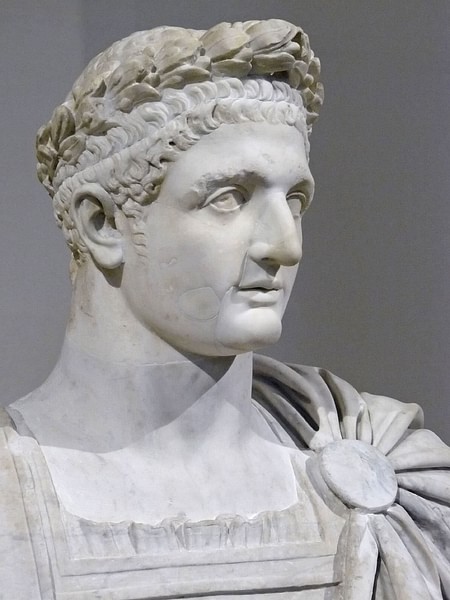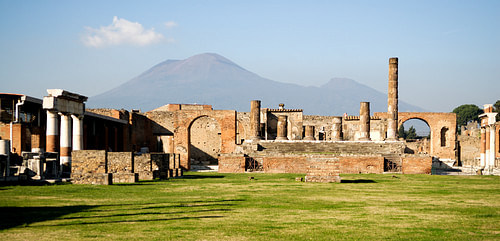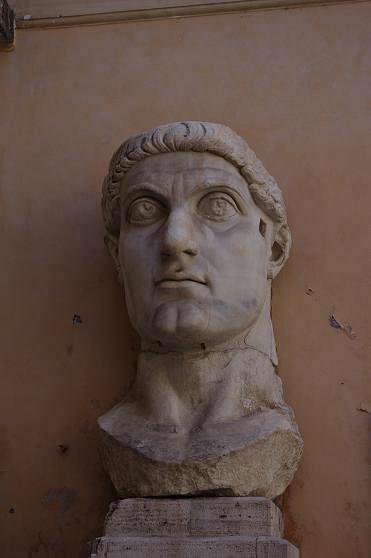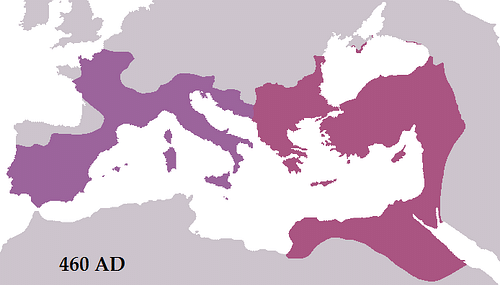Diocletian Expanded Imperial Leadership to Two and Then Again to Four in Order to Address
The Roman Empire, at its pinnacle (c. 117 CE), was the nearly extensive political and social structure in western civilization. Past 285 CE the empire had grown too vast to be ruled from the central government at Rome and so was divided by Emperor Diocletian (r. 284-305 CE) into a Western and an Eastern Empire. The Roman Empire began when Augustus Caesar (r. 27 BCE-14 CE) became the get-go emperor of Rome and concluded, in the west, when the terminal Roman emperor, Romulus Augustulus (r. 475-476 CE), was deposed by the Germanic King Odoacer (r. 476-493 CE). In the east, it continued as the Byzantine Empire until the death of Constantine XI (r. 1449-1453 CE) and the autumn of Constantinople to the Ottoman Turks in 1453 CE. The influence of the Roman Empire on western civilization was profound in its lasting contributions to virtually every attribute of western culture.
The Early Dynasties
Following the Boxing of Actium in 31 BCE, Gaius Octavian Thurinus, Julius Caesar'southward nephew and heir, became the start emperor of Rome and took the name Augustus Caesar. Although Julius Caesar is often regarded equally the first emperor of Rome, this is incorrect; he never held the title `Emperor' only, rather, `Dictator', a title the Senate could non help merely grant him, as Caesar held supreme military and political power at the time. In contrast, the Senate willingly granted Augustus the title of emperor, lavishing praise and power on him because he had destroyed Rome's enemies and brought much-needed stability.
Augustus: "I found Rome a metropolis of dirt but left it a metropolis of marble."
Augustus ruled the empire from 31 BCE until fourteen CE when he died. In that time, every bit he said himself, he "plant Rome a city of clay but left it a metropolis of marble." Augustus reformed the laws of the urban center and, by extension, the empire's, secured Rome's borders, initiated vast building projects (carried out largely by his faithful general Agrippa (50. 63-12 BCE), who congenital the kickoff Pantheon), and secured the empire a lasting name as i of the greatest, if not the greatest, political and cultural powers in history. The Pax Romana (Roman Peace), also known every bit the Pax Augusta, which he initiated, was a time of peace and prosperity hitherto unknown and would last over 200 years.
Following Augustus' expiry, power passed to his heir, Tiberius (r. xiv-37 CE), who continued many of the emperor'south policies merely lacked the forcefulness of character and vision which and so defined Augustus. This trend would continue, more or less steadily, with the emperors who followed: Caligula (r. 37-41 CE), Claudius (r. 41-54 CE), and Nero (r. 54-68 CE). These first five rulers of the empire are referred to as the Julio-Claudian Dynasty for the ii family names they descended from (either by birth or through adoption), Julius and Claudius. Although Caligula has become notorious for his depravity and apparent insanity, his early on rule was commendable as was that of his successor, Claudius, who expanded Rome's power and territory in Britain; less so was that of Nero. Caligula and Claudius were both assassinated in office (Caligula by his Praetorian Baby-sit and Claudius, plainly, past his wife). Nero's suicide ended the Julio-Claudian Dynasty and initiated the menstruum of social unrest known as The Yr of the Iv Emperors.
These four rulers were Galba, Otho, Vitellius, and Vespasian. Following Nero'due south suicide in 68 CE, Galba assumed rule (69 CE) and virtually instantly proved unfit for the responsibility. He was assassinated by the Praetorian Guard. Otho succeeded him swiftly on the very day of his death, and ancient records indicate he was expected to make a good emperor. General Vitellius, even so, sought power for himself and and then initiated the brief civil war which ended in Otho'south suicide and Vitellius' rising to the throne.
Vitellius proved no more fit to rule than Galba had been, as he nearly instantly engaged in luxurious entertainments and feasts at the expense of his duties. The legions declared for General Vespasian every bit emperor and marched on Rome. Vitellius was murdered by Vespasian'due south men, and Vespasian (r. 69-79 CE) took power exactly i yr from the twenty-four hour period Galba had first ascended to the throne.
Vespasian founded the Flavian Dynasty which was characterized by massive edifice projects, economic prosperity, and expansion of the empire. Vespasian reign was prosperous as evidenced by his building projects which included initial construction of the Flavian Amphitheatre (the famous Coliseum of Rome) which his son Titus (r. 79-81 CE) would complete. Titus' early reign saw the eruption of Mount Vesuvius in 79 CE which buried the cities of Pompeii and Herculaneum.

Roman Emperor Domitian, Louvre
Aboriginal sources are universal in their praise for his treatment of this disaster as well equally the great fire of Rome in lxxx CE. Titus died of a fever in 81 CE and was succeeded past his brother Domitian (r. 81-96 CE). Domitian expanded and secured the boundaries of Rome, repaired the damage to the city caused by the nifty burn, continued the building projects initiated by his brother, and improved the economy of the empire. Nevertheless, his autocratic methods and policies fabricated him unpopular with the Roman Senate, and he was assassinated in 96 CE.
The 5 Good Emperors
Domitian'southward successor was his advisor Nerva who founded the Nervan-Antonin Dynasty which ruled Rome 96-192 CE. This period is marked by increased prosperity owing to the rulers known as The Five Proficient Emperors of Rome. Between 96 and 180 CE, v exceptional men ruled in sequence and brought the Roman Empire to its height:
- Nerva (r. 96-98 CE)
- Trajan (r. 98-117 CE)
- Hadrian (r. 117-138 CE)
- Antoninus Pius (r. 138-161 CE)
- Marcus Aurelius (r. 161-180 CE)
Under their leadership, the Roman Empire grew stronger, more stable, and expanded in size and scope. Lucius Verus and Commodus are the last ii of the Nervan-Antonin Dynasty. Verus was co-emperor with Marcus Aurelius until his decease in 169 CE and seems to have been fairly ineffective. Commodus (r. 180-192 CE), Aurelius' son and successor, was one of the most disgraceful emperors Rome always saw and is universally depicted equally indulging himself and his whims at the expense of the empire. He was strangled past his wrestling partner in his bath in 192 CE, ending the Nervan-Antonin Dynasty and raising the prefect Pertinax (who about likely engineered Commodus' assassination) to power.

Pompeii and Mt. Vesuivus
The Severan Dynasty
Pertinax governed for only iii months earlier he was assassinated. He was followed, in rapid succession, by four others in the menses known as The Twelvemonth of the Five Emperors, which culminated in the rising of Septimus Severus to power. Severus (r. 193-211 CE), founded the Severan Dynasty, defeated the Parthians, and expanded the empire. His campaigns in Africa and United kingdom of great britain and northern ireland were extensive and costly and would contribute to Rome's later on financial difficulties. He was succeeded past his sons Caracalla and Geta, until Caracalla had his brother murdered.

Roman Beach Attack
Caracalla ruled until 217 CE, when he was assassinated by his babysitter. It was under Caracalla's reign that Roman citizenship was expanded to include all gratis men inside the empire. This constabulary was said to accept been enacted as a ways of raising tax revenue, only because, afterward its passage, in that location were more people the central government could taxation. The Severan Dynasty continued, largely under the guidance and manipulation of Julia Maesa (referred to as `empress'), until the assassination of Alexander Severus (r. 222-235 CE) in 235 CE which plunged the empire into the anarchy known every bit The Crisis of the 3rd Century (lasting from 235-284 CE).
Two Empires: East & West
This menses, also known as The Purple Crisis, was characterized by constant civil state of war, as various military leaders fought for control of the empire. The crunch has been farther noted by historians for widespread social unrest, economical instability (fostered, in part, by the devaluation of Roman currency by the Severans), and, finally, the dissolution of the empire which broke into 3 separate regions. The empire was reunited by Aurelian (270-275 CE) whose policies were further adult and improved upon by Diocletian who established the Tetrarchy (the dominion of 4) to maintain society throughout the empire.
The Imperial Crunch was characterized past constant civil war, as various military leaders fought for control of the empire.
All the same, the empire was still so vast that Diocletian divided it in half in c.285 CE to facilitate more efficient administration by elevating one of his officers, Maximian (r. 286-305 CE) to the position of co-emperor. In and so doing, he created the Western Roman Empire and the Eastern Roman Empire (also known as the Byzantine Empire). Since a leading cause of the Imperial Crisis was a lack of clarity in succession, Diocletian decreed that successors must be called and canonical from the kickoff of an individual's dominion. Ii of these successors were the generals Maxentius and Constantine. Diocletian voluntarily retired from rule in 305 CE, and the tetrarchy dissolved equally rival regions of the empire vied with each other for dominance. Following Diocletian's death in 311 CE, Maxentius and Constantine plunged the empire again into civil war.
Constantine & Christianity
In 312 CE Constantine defeated Maxentius at the Battle of the Milvian Bridge and became sole emperor of both the Western and Eastern Empires (ruling from 306-337 CE but holding supreme power 324-307 CE). Assertive that Jesus Christ was responsible for his victory, Constantine initiated a serial of laws such as the Edict of Milan (313 CE) which mandated religious tolerance throughout the empire and, specifically, tolerance for the faith which came to known equally Christianity.

The Colossus of Constantine
In the aforementioned way that before Roman emperors had claimed a special human relationship with a deity to augment their dominance and standing (Caracalla with Serapis, for example, or Diocletian with Jupiter), Constantine chose the effigy of Jesus Christ. At the First Council of Nicea (325 CE), he presided over the gathering to codify the faith and decide on of import issues such as the divinity of Jesus and which manuscripts would be collected to form the book known today as The Bible. He stabilized the empire, revalued the currency, and reformed the armed services, also every bit founding the city he called New Rome on the site of the former urban center of Byzantium (modern-twenty-four hour period Istanbul) which came to exist known as Constantinople.
He is known as Constantine the Nifty owing to subsequently Christian writers who saw him as a mighty champion of their religion but, as has been noted by many historians, the honorific could as easily be attributed to his religious, cultural, and political reforms, as well every bit his skill in boxing and his large-scale building projects. After his decease, his sons inherited the empire and, adequately quickly, embarked on a series of conflicts with each other which threatened to undo all that Constantine had accomplished.
His iii sons, Constantine 2, Constantius Two, and Constans divided the Roman Empire betwixt them merely presently fell to fighting over which of them deserved more. In these conflicts, Constantine II and Constans were killed. Constantius Ii died later after naming his cousin Julian his successor and heir. Emperor Julian ruled for only two years (361-363 CE) and, in that time, tried to render Rome to her onetime celebrity through a serial of reforms aimed at increasing efficiency in government.
As a Neo-Platonic philosopher, Julian rejected Christianity and blamed the faith, and Constantine's advocacy for it, for the refuse of the empire. While officially proclaiming a policy of religious tolerance, Julian systematically removed Christians from influential government positions, banned the teaching and spread of the religion, and barred Christians from armed services service. His decease, while on entrada confronting the Persians, ended the dynasty Constantine had begun. He was the terminal heathen emperor of Rome and came to be known every bit `Julian the Apostate' for his opposition to Christianity.

Byzantine Empire c. 460 CE
After the brief dominion of Jovian, who re-established Christianity as the dominant organized religion of the empire and repealed Julian's diverse edicts, the responsibility of emperor barbarous to Theodosius I. Theodosius I (r. 379-395 CE) took Constantine'due south and Jovian's religious reforms to their natural ends, outlawed pagan worship throughout the empire, closed the schools and universities, and converted pagan temples into Christian churches afterward proclaiming Christianity Rome's state faith in 380 CE.
The unity of social duties & religious belief which paganism provided was severed by the institution of Christianity.
Information technology was during this time that Plato's famous Academy was airtight by Theodosius' decree. Many of his reforms were unpopular with both the Roman aristocracy and the common people who held to the traditional values of heathen practice. The unity of social duties and religious conventionalities which paganism provided was severed by the establishment of a religion which removed the gods from the earth and human society and proclaimed only one God who ruled from the heavens.
This new god, unlike the gods of erstwhile, had no special interest in Rome - he was the god of all people - and this distanced the faith of Rome from the land of Rome. Previously, Roman religious belief was state-sponsored and the rituals and festivals went to enhancing the condition of the government. Theodosius I devoted so much attempt to promoting Christianity that he seems to accept neglected other duties as emperor and would be the last to rule both Eastern and Western Empires.
The Fall of the Roman Empire
From 376-382 CE, Rome fought a series of battles against invading Goths known today as the Gothic Wars. At the Battle of Adrianople, 9 August 378 CE, the Roman Emperor Valens (r. 364-378 CE) was defeated, and historians mark this event as pivotal in the decline of the Western Roman Empire. Various theories have been suggested as to the cause of the empire'south fall but, even today, in that location is no universal understanding on what those specific factors were. Edward Gibbon has famously argued in his The History of the Decline and Fall of the Roman Empire that Christianity played a pivotal role, in that the new religion undermined the social mores of the empire which paganism provided.
The theory that Christianity was a root cause in the empire's fall was debated long earlier Gibbon, however, as the theologian Orosius (l. c. 5th century CE) argued Christianity's innocence in Rome'south reject as early as 418 CE. Orosius claimed it was primarily paganism itself and pagan practices which brought well-nigh the fall of Rome. Other contributing factors to Rome's fall include:
- Political instability due to size of empire
- The self-involvement of the two halves of the empire
- Invasion of barbarian tribes
- Regime corruption
- Mercenary armies
- Over-reliance on slave labor
- Massive unemployment and inflation
The ungovernable vastness of the empire, even divided in two, made it difficult to manage. The Eastern Empire flourished while the Western Empire struggled and neither gave much thought to helping the other. Eastern and Western Rome saw each other more equally competitors than teammates and worked primarily in their own self-interest. The growing strength of the Germanic tribes and their abiding incursions into Rome could have been dealt with more effectively if non for government abuse, especially among provincial governors, and off-white treatment of the Goths by the Romans overall.
The Roman military machine, manned largely with barbarian mercenaries who had no ethnic ties to Rome, could no longer safeguard the borders as efficiently as they in one case had nor could the government equally easily collect taxes in the provinces. Further, the debasement of the currency, begun nether the Severan Dynasty, had steadily encouraged inflation and slave labor, which was widespread, deprived lower-grade citizens of jobs and then unemployment levels soared. The inflow of the Visigoths in the empire in the third century CE, fleeing from the invading Huns, and their subsequent rebellions has also been cited a contributing gene in the turn down.

Invasions of the Roman Empire
The Western Roman Empire officially ended four September 476 CE, when Emperor Romulus Augustulus was deposed past the Germanic King Odoacer (though some historians date the stop as 480 CE with the death of Julius Nepos). The Eastern Roman Empire continued on as the Byzantine Empire until 1453 CE, and though known early on every bit but `the Roman Empire', it did not much resemble that entity at all. The Western Roman Empire would become re-invented later as The Holy Roman Empire (962-1806 CE), simply that construct, besides, was far removed from the Roman Empire of artifact and was an `empire' in name only.
Legacy of the Roman Empire
The inventions and innovations which were generated by the Roman Empire profoundly altered the lives of the ancient people and continue to exist used in cultures around the world today. Advancements in the structure of roads and buildings, indoor plumbing, aqueducts, and even fast-drying cement were either invented or improved upon past the Romans. The calendar used in the West derives from the one created by Julius Caesar, and the names of the days of the week (in the romance languages) and months of the year also come from Rome. Even the practice of returning some purchase ane finds i does not desire comes from Rome whose laws made it legal for a consumer to bring back some lacking or unwanted trade to the seller.
Apartment complexes (known every bit `insula), public toilets, locks and keys, newspapers, fifty-fifty socks all were developed past the Romans as were shoes, a postal system (modeled afterward the Persians), cosmetics, the magnifying glass, and the concept of satire in literature. During the time of the empire, meaning developments were also advanced in the fields of medicine, police force, faith, government, and warfare. The Romans were adept at borrowing from, and improving upon, those inventions or concepts they found amidst the indigenous populace of the regions they conquered. Information technology is therefore difficult to say what is an `original' Roman invention and what is an innovation on a pre-existing concept, technique, or tool. It tin can safely be said, yet, that the Roman Empire left an enduring legacy which continues to affect the way in which people live in the present day.
This article has been reviewed for accuracy, reliability and adherence to academic standards prior to publication.
Source: https://www.worldhistory.org/Roman_Empire/
0 Response to "Diocletian Expanded Imperial Leadership to Two and Then Again to Four in Order to Address"
Publicar un comentario